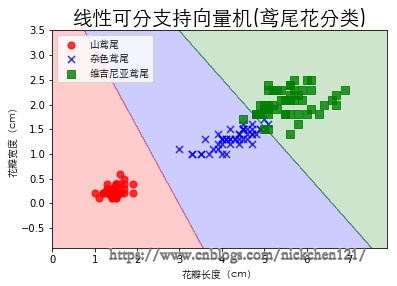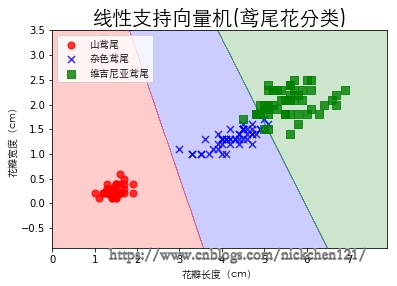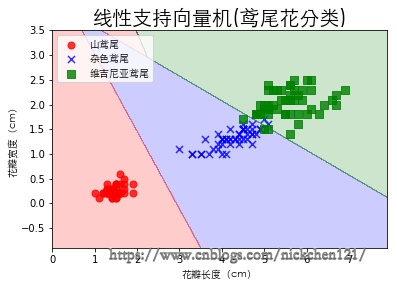02-32 线性支持向量9-机(鸢尾花分类)
Posted nickchen121
tags:
篇首语:本文由小常识网(cha138.com)小编为大家整理,主要介绍了02-32 线性支持向量9-机(鸢尾花分类)相关的知识,希望对你有一定的参考价值。
目录
更新、更全的《机器学习》的更新网站,更有python、go、数据结构与算法、爬虫、人工智能教学等着你:https://www.cnblogs.com/nickchen121/
线性支持向量机(鸢尾花分类)
一、导入模块
import numpy as np
import pandas as pd
import matplotlib.pyplot as plt
from matplotlib.colors import ListedColormap
from matplotlib.font_manager import FontProperties
from sklearn import datasets
from sklearn.svm import SVC
%matplotlib inline
font = FontProperties(fname='/Library/Fonts/Heiti.ttc')二、获取数据
iris_data = datasets.load_iris()
X = iris_data.data[:, [2, 3]]
y = iris_data.target
label_list = ['山鸢尾', '杂色鸢尾', '维吉尼亚鸢尾']三、构建决策边界
def plot_decision_regions(X, y, classifier=None):
marker_list = ['o', 'x', 's']
color_list = ['r', 'b', 'g']
cmap = ListedColormap(color_list[:len(np.unique(y))])
x1_min, x1_max = X[:, 0].min()-1, X[:, 0].max()+1
x2_min, x2_max = X[:, 1].min()-1, X[:, 1].max()+1
t1 = np.linspace(x1_min, x1_max, 666)
t2 = np.linspace(x2_min, x2_max, 666)
x1, x2 = np.meshgrid(t1, t2)
y_hat = classifier.predict(np.array([x1.ravel(), x2.ravel()]).T)
y_hat = y_hat.reshape(x1.shape)
plt.contourf(x1, x2, y_hat, alpha=0.2, cmap=cmap)
plt.xlim(x1_min, x1_max)
plt.ylim(x2_min, x2_max)
for ind, clas in enumerate(np.unique(y)):
plt.scatter(X[y == clas, 0], X[y == clas, 1], alpha=0.8, s=50,
c=color_list[ind], marker=marker_list[ind], label=label_list[clas])四、线性可分支持向量机
4.1 训练模型
svm = SVC(kernel='linear', random_state=1)
svm.fit(X, y)SVC(C=1.0, cache_size=200, class_weight=None, coef0=0.0,
decision_function_shape='ovr', degree=3, gamma='auto_deprecated',
kernel='linear', max_iter=-1, probability=False, random_state=1,
shrinking=True, tol=0.001, verbose=False)4.2 可视化
plot_decision_regions(X, y, classifier=svm)
plt.xlabel('花瓣长度(cm)', fontproperties=font)
plt.ylabel('花瓣宽度(cm)', fontproperties=font)
plt.title('线性可分支持向量机(鸢尾花分类)', fontproperties=font, fontsize=20)
plt.legend(prop=font)
plt.show()
五、线性支持向量机
5.1 训练模型(C=0.01)
svm = SVC(kernel='linear', C=0.01, random_state=1)
svm.fit(X, y)SVC(C=0.01, cache_size=200, class_weight=None, coef0=0.0,
decision_function_shape='ovr', degree=3, gamma='auto_deprecated',
kernel='linear', max_iter=-1, probability=False, random_state=1,
shrinking=True, tol=0.001, verbose=False)5.2 可视化
plot_decision_regions(X, y, classifier=svm)
plt.xlabel('花瓣长度(cm)', fontproperties=font)
plt.ylabel('花瓣宽度(cm)', fontproperties=font)
plt.title('线性支持向量机(鸢尾花分类)', fontproperties=font, fontsize=20)
plt.legend(prop=font)
plt.show()
5.3 训练模型(C=100)
svm = SVC(kernel='linear', C=100, random_state=1)
svm.fit(X, y)SVC(C=100, cache_size=200, class_weight=None, coef0=0.0,
decision_function_shape='ovr', degree=3, gamma='auto_deprecated',
kernel='linear', max_iter=-1, probability=False, random_state=1,
shrinking=True, tol=0.001, verbose=False)5.4 可视化
plot_decision_regions(X, y, classifier=svm)
plt.xlabel('花瓣长度(cm)', fontproperties=font)
plt.ylabel('花瓣宽度(cm)', fontproperties=font)
plt.title('线性支持向量机(鸢尾花分类)', fontproperties=font, fontsize=20)
plt.legend(prop=font)
plt.show()
以上是关于02-32 线性支持向量9-机(鸢尾花分类)的主要内容,如果未能解决你的问题,请参考以下文章